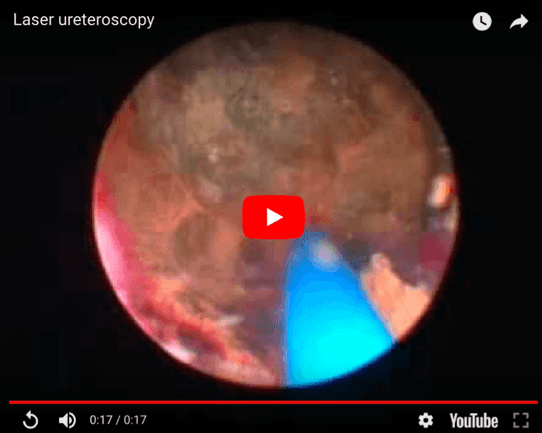Ureteroscopy and laser treatment for kidney stones (Telescopic Operation)
Why do I need this operation?
Your surgeon would have explained to you why you require this procedure, which can either be used for diagnostic purposes, or for treating a kidney stone. If you have a kidney stone it may be in the ureter (the tube which drains urine from the kidney to the bladder) or in the kidney.
This operation is performed using either a long, thin, semi-rigid or flexible telescope. This is passed up the natural urinary passage (urethra) into the bladder and up to the stone or the problem in the ureter or kidney. The procedure requires a general anaesthetic with a hospital stay usually of 1 to 3 days. You may be able to go home the same day (this will depend on your individual circumstances and will be discussed with you by your consultant).
What can I expect before the operation?
You will be seen in a pre-assessment clinic a few days before the operation and have blood tests if needed. You will also be required to produce a fresh, mid-stream urine specimen.
• It is important to bring all your medication or a list of medication to the pre-assessment, and inform the doctor about all or any new medical problems.
• Please tell the doctor if you have any allergies to medication or allergy to the dye used to take special X-rays in the past.
• You might have a further X-ray of your abdomen on the day of the operation to check the latest position of your stone.
• If you are a woman of child bearing age it is important to let the doctor or the nurse know if there is any possibility of your being pregnant. If in doubt we will perform a pregnancy test. This is important to avoid radiation exposure to a baby in the womb during the procedure.
How is the operation performed?
While you are under the general anaesthetic the consultant will examine your bladder with a long, thin, semi-rigid or flexible telescope and then pass a small guide wire up the ureter beyond the kidney stone. Sometimes it will be necessary to stretch the opening of the ureter into the bladder. The surgeon will then pass a long, thin, semi-rigid or flexible telescope up the ureter to the stone. If the kidney stone is small enough to be extracted intact it will be removed with a special basket. If however the stone needs to be broken up, this will be done using either a laser or a small vibrating probe. If fragments can then be removed they may be sent for analysis.
Sometimes it is necessary to leave a stent (this is a long thin plastic flexible tube which extends from the kidney to the bladder) in the ureter if it has not been possible to fragment the stone or if the ureter looks inflamed. This will be left inside you temporarily and be taken out in a few weeks or left in until further treatment of the stone is necessary. The stent may cause pain, frequent desire and urgency to pass water or blood in your urine for a few days.
What can I expect after the operation?
You may have a catheter in your bladder to drain your urine. Your urine may be coloured with blood. The catheter will be removed once the consultants are satisfied with your progress.
• You may have an intravenous drip until you are able to drink and eat normally.
• You will usually be given antibiotics when you are anaesthetised and if needed post-operatively as well to prevent infection.
• You will be given appropriate painkillers after the procedure.
You need to maintain a high fluid intake (4 – 6 pints per day): this will help clear the blood in your urine and flush out stone fragments and reduce the risk of constipation.
• Try to get active as soon as possible after the operation to reduce the chances of pneumonia and clots in your legs.
• Do not drive until you feel able to make an emergency stop.
• You may see some blood in your urine up to 2 weeks after the operation. If this persists contact your GP or alternatively contact the Urology ward to which you were admitted.
• If you develop high fever or chills contact the Urology ward to which you were admitted.
What are the risks of this operation?
- Bleeding in the urine usually settles in a few days but can last for 2 or 3 weeks.
•
- Infection of the bladder is common although all patients are given antibiotics to minimise this risk. Some stones have bacteria trapped within them which are then released during the operation. Severe infection occurs in less than 1% of patients.
•
- In case of failure to reach the stone due to a narrow ureter, a stent might be inserted and a second procedure might be needed at a later stage.
- Damage to the ureter is uncommon and might lead to the need for a stent.
Very rarely an open procedure to repair the damage may be necessary.
•
- Chest Infection might arise if you are a smoker or if you have pre-existing breathing or chest problems. It is important to stop smoking before the operation and inform the doctor if you have had any recent chest infection. Stopping smoking before the operation will also reduce the risk of clots forming in your legs.
Schematic representation of Ureteroscopy and stone removal. (from European Association on Urology)









